My break at the Kunene river lodge is like living another life. In a short week staying there, I enjoy delicious breakfasts over the Cunene river and I can blog facing Angola on the other side.
Electricity comes to this very remote place via cables from the nearest town, Opuwo, 140 km away. No diesel generator? It is quite a change for me. Internet is quite slow, but it is already an achievement to have a connection when there is not even a cellphone coverage. The food is good, the place is clean, the service is high, … Regarding landscapes and culture, Africa has it all; why can’t people make it look nice and attractive like this everywhere else?
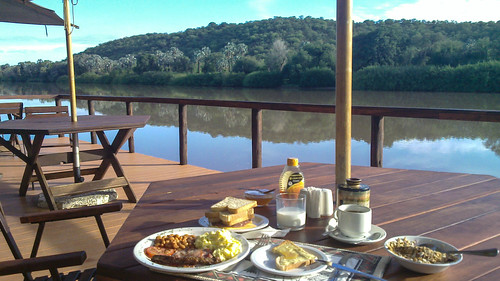
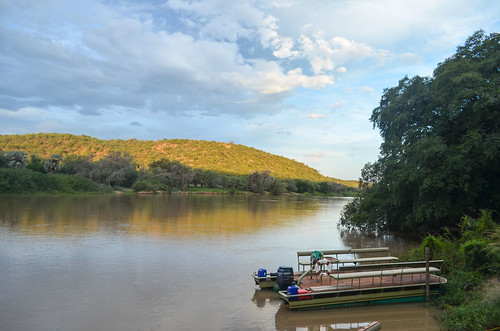
I still have to take care of my gear: re-patching my air mattress, re-patching the slow leaks on my bicycle tubes, re-tensioning and cleaning my chain, washing my tent and clothes, and figuring out why my MSR WhisperLite stove is working less and less as it should. Despite cleaning it, it keeps making long yellow flames so high that I burn my fingers when I want to take my pot out of it.
Maybe that’s because of the cheap lamp oil I tried in Cameroon, which didn’t really burn well and produced lots of soot. This time, I disassemble it entirely, opening the burner. Under the burner cap are hidden seven thin plates called “flame ring package”, some flat, some wavy, creating a baffle structure. They are quite corroded (just like for him) and I spend a good hour scraping them and painting them with oil and a toothbrush. Reassembly and verdict: it burns small blue flames, just like in its first days!
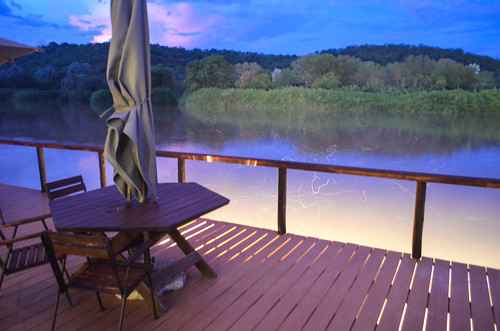
At the lodge, the big monitor lizards come to the camp during the night to find food, and so do the monkeys. They look like crocodiles until I see their tongue “smelling” the air. I also meet several travelers, it’s an event rare enough to be enjoyed. One couple is travelling overland in a truck with a home-built interior.

On that picture, both vehicles are made in Germany and can be relied on to cross the continent. But only one of them has a kitchen, a shower, two beds, solar panels, and enough water to stay in the wild for 3 weeks. Can you find which one it is?
There is also something I almost forgot to do: to switch my handlebar mirror from left to right, as I am (should be) now cycling on the left side of the road. Doing so, I got my money stuck deep inside, that I recovered only after mounting my tent poles to push it out from the other end. I’m not disclosing here an important cycle touring secret, as it’s already on the internet: the seat tube and handlebar tube are good places to store spare spokes and cash. I keep there some US dollars, just in case.
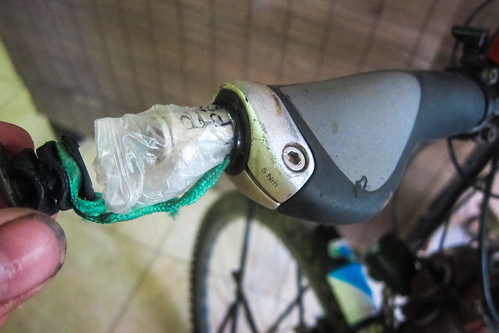
During these peaceful days, well treated by the owners Hillary and Pete, I also realized that I am reaching an advanced stage of serenity: I can now contemplate the end. I don’t know how could the probability be calculated for a cyclist to make it to South Africa from Morocco, considering the risks of not getting visas, of getting seriously ill instead, of getting his passport stolen, of getting into trouble in unstable countries, of breaking a part of the gear that can’t be replaced, etc. Now, I feel serene because I arrived here alive and with all my gear. The risks are reduced from now on.
It would be dangerous to relax, thinking that cycling until Cape Town will be simple: Namibia will be hot during the day, cold at night, and I’ll have to carry much more water for the 100+ km stretches without any house. South Africa … well, there is this “don’t open your windows and keep your doors locked” policy to avoid carjacking in the cities, so I’ll have to be careful. I just drafted an itinerary for Namibia, which has much to see (it has tourist maps!), and it will take me time to zigzag through this big country. But it should be rewarding.
The access path to the lodge is rocky, but it’s very short: I am soon on the main road from Swartbooi’s Drift to Opuwo, and considered the remoteness, it’s of an excellent quality.
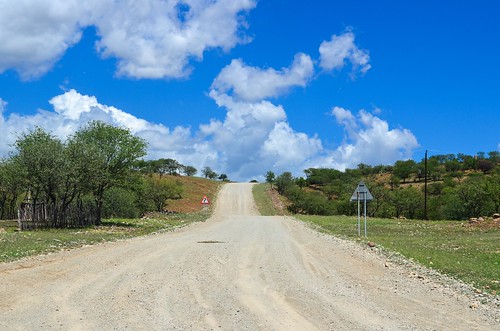
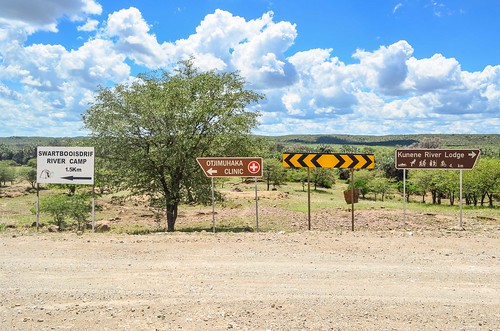
Namibia has one of the best road networks of Africa. Out of the 45000 kilometers of roads, only 5000 are asphalted, because the population of 2,1 million and the very low density in some regions don’t justify paving everything. However, the gravel roads are maintained regularly. Pete, from the lodge, told me that the Ruacana – Swartbooi’s Drift road, where I saw only 3 cars passing in an afternoon and the following morning, is graded at least four times a year. This is to be compared with busy roads in a terrible state, abandoned by the government, like in Cameroon, making villagers unable to export the products of their agriculture. Well, thanks to the cash-loaded Chinese (and to them only), this is going to change.
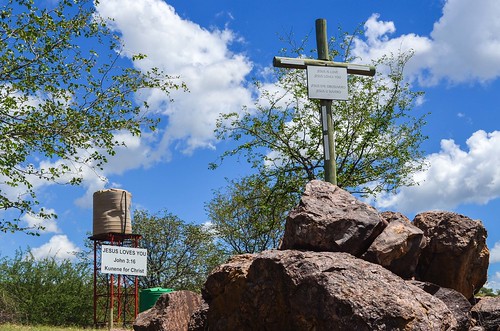
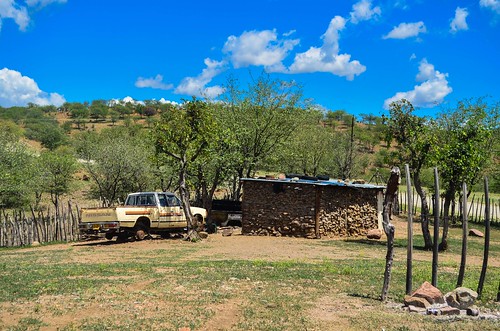
Swartbooi’s Drift hosts the Dorslandtrekkers memorial. The plate reads: “This monument commemorates the coming of more than 2000 Afrikaners in the late 1920’s to what was then South West Africa. They were descendants of the Dorslandtrekkers (Thirstland Trekkers) from South Africa who had settled in Angola since 1880. After about 50 years dissension with the Portuguese government concerning mother tongue education, citizenship tenure, religion and military service resulted in their repatriation to South West Africa in 1928/1929. Supported by government loans most of them became established farmers who played significant role in their new country.”
The Boers had traveled in the 19th century from South Africa through Botswana until Humpata, near Lubango, where I camped after climbing up the Serra da Leba.

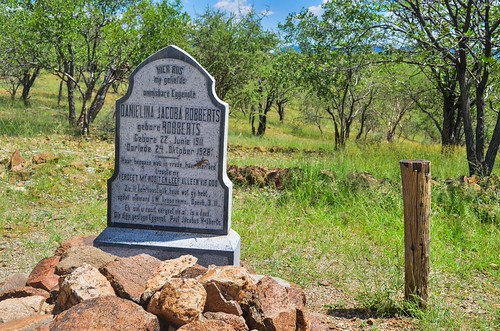
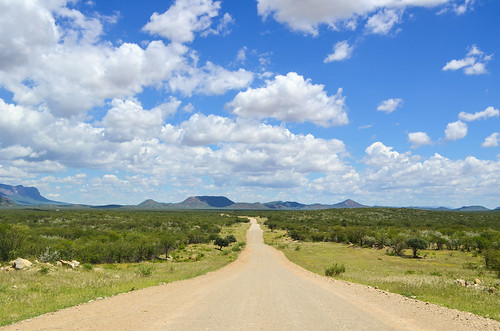
Namibia is the third less densely populated country in the world (2.56 people/km2). I thereby complete the Top 3 of the emptiest countries in the world (Mongolia comes first with 1.76/km2, Western Sahara second with 2.25/km2). I also visited number 4, 5 and 7 (Australia, Iceland, Mauritania). Nature in “empty” countries is always impressive.
Furthermore, this region of Namibia is even less populated: “With 16,000 or so inhabitants, 5,000 of them Himba, Kaokoland has a population density of only one person to every two square kilometers.“. Kaokoland is the name of the former Bantustan and its borders are closely matching with the Kunene administrative region.
I have to say that until Opuwo, apart from a small settlement and a shebeen at a crossroads, these 140 kilometers are very lonely.

There is a sodalite mine in the area, but the path leading there is too difficult, I abandon after a kilometer and turn around.
By the way, about population density, there is a graph in the Nakambale museum warning against “the population burden”, in the next region, where Oshakati is found.
“The population burden. […] With an average of 10 people per km2, it is the most densely populated part of Namibia. […] The population has increased 9-fold since 1921 (editor’s note: world increased 4-fold over the same period), and at the present growth rate will be doubled by 2020. […] Will this burden be too heavy?”
For information, 10 people per km2 is roughly 10 times less than France and 20 times less than Switzerland.

On the road to Opuwo, there is supposed to be a chest-deep river crossing. I am prepared and wear flip-flops, but it’s actually much better than expected: the water is barely reaching my ankles. It has been raining a lot in the past weeks but I hope the rainy season is over for good now.
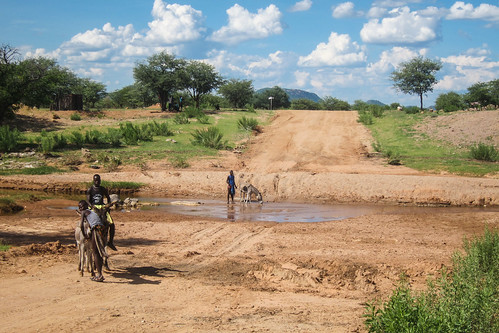
I was talking about the shebeen at a crossroads halfway between Opuwo and the Kunene river. There are only two small houses there, and I guess nothing to do. The surroundings are speaking for themselves.
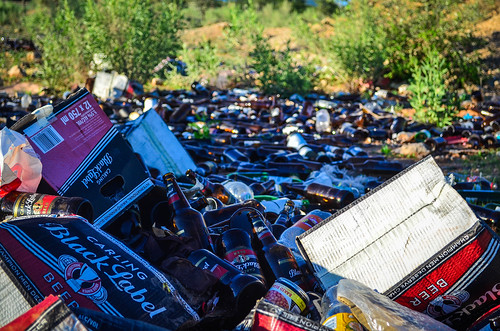
In Namibia, glass beer bottles are not collected for recycling. Only 14 dollars (1 €) for a large one (750 mL). It’s perfect to make business out of people who never have money but will always be found at the shebeen.
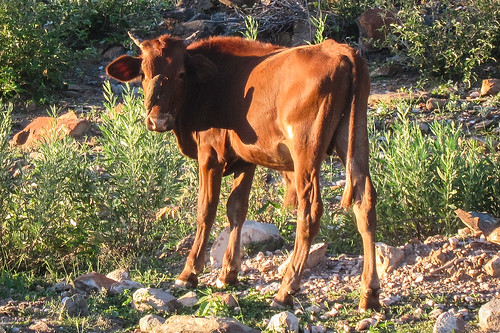
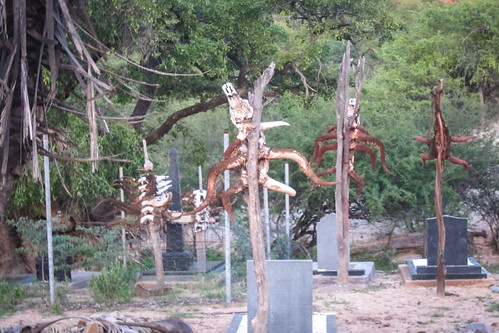
With such a low density of population, it shouldn’t be hard to find a hidden camp spot. It is not easy either, because of the stones that cover most of the land. Flat areas are bushy, and these bushes have too many nasty thorns.

My shoes are way too bad for where I take them. Not only they suck water in (with a hole in the sole, it’s easy), but also provide very little resistance on the ground: while walking a bit out of the road, a very long thorn once got through the sole straight into my foot. It’s not pleasant at all.
When I get out of my tent in the morning, my first instinct is to check the tire pressure. The rear one is half flat. If it’s a slow leak, so I can either be lazy and pump it up every 15 km, or patch it now and feel better. I’m not happy about unloading the bike and patch it with an empty belly, especially with all the flies around and the small water I have at my disposal.
But it’s better like this, as I have shade right now, and may not find it when I really need it. The flies are everywhere anyway, landing on my lips and eyelids every time I stop. I have been carrying since Switzerland a thin 40 L dry bag that barely served. If it works to keep things inside dry, it should be working for keeping water inside too. I filled it up yesterday to have an extra 4 or 6 liters of water, and it works well.

After reassembling the wheel, I’m finally ready for another hot day. I get back to the road walking and watching carefully for the thorns, and can hop on my bike. There is a group of kids down the hill, walking on the road, but they jump in the bush as soon as they see me coming.
I’m used to kids being afraid of me. At the same moment, I realize my gears are not working anymore: I forgot to plug the external Rohloff gear shift mechanism! And having cycled with it, the cables were pulled up towards the frame. By the time I figure out where to pull back and clip the socket to the hub, the kids have returned from the bush to the road and walked up to me.
I show my camera and am surprised they want to play with it. Like the adults I’ve met, they don’t speak a word of English. Unlike the adults, these Himba girls enjoy taking poses.
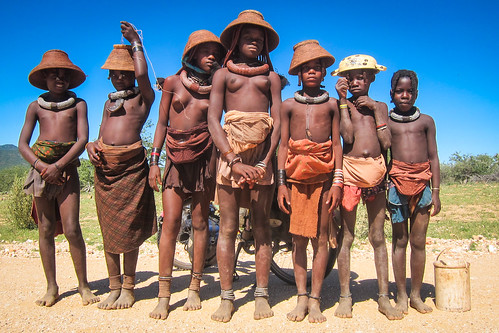
The Tsumeb museum tells the story of the Himba:
The Ovahimba people make up about 2% of Namibia’s total population. Due to their geographical isolation and their natural conservatism, they haven’t been exposed to western influences and they managed to preserve their traditions. Originally, the Ovahimba belonged to the Herero people. Some Herero stayed in Kaokoland when the majority moved south in the 18th century. Several conflicts with the Nama people led to a major loss of cattle, so they were forced to change their lifestyle and become hunters and gatherers. As the danger grew bigger, they crossed the Kunene River and fled to Angola. There, they were called “ovahimba” (beggar). With the help of a Herero leader named Vita, the Ovahimba returned to Kaokoland in the early 20th century. Today, they live again as semi-nomadic pastoral people, complemented by hunting, a little farming and gathering. Ancestral worship plays an important role in their life, especially their Sacred Fire (“okuruwo”). The fire symbolizes the constant connection between the living family members and those who are deceased. Therefore, it always has to be kept burning. The ancestors, in the form of the Sacred Fire, are invocated for every initiation ritual and asked for protection. Hair style and jewellery are of extreme importance, too. They show a person’s particular social status.

It is also written that:
Himba girls wear two plaits “ozondate” on the forehead and the “ombwena” necklace until puberty. Pubescent girls wear many thin plaits. The necklaces they wear indicate that they have passed the puberty ceremony. At about the age of twelve, both boys and girls have the front bottom teeth (incisor) knocked out and the two top front teeth filed into an upside “V”. This is their tribal identification. Between the ages of 15-16 years, the girls take part in the “ekori” ceremony, where they are given the “ekori” leather headdress to wear, indicating that they are now of marriageable age. Theses headdresses are worn until their first child’s birth and after that only on special occasions like weddings or funerals. After a year of marriage or the birth of the first child, the “ekori” headdress is replaced by the “erembe” headdress.
For boys, a single thin plait indicates that he has just reached puberty, and not yet attained marriageable age. A Himba youth is of marriageable age if it is indicated by two plaits. As soon as a man is married, the plaits are put up and the head is covered by a cloth or a leather cap ( “ombwiya” headdress). If his wife or one of his nearest family members passes away, the “ombwiya” must be removed and mustn’t be worn until the prescribed period of mourning is over.
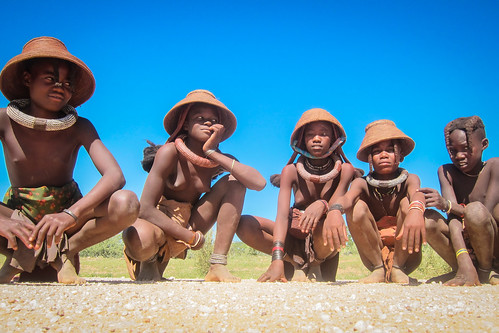
I had already seen the Himba in Chitado (Angola) and near Ruacana. I can understand why most of the adults are not so friendly and always asking for money. The Himba are one of the main “attractions” of the very touristic country of Namibia (yes, this touristic), and unlike the sand dunes and the elephants, they must be quite annoyed at people driving 4×4 from far away just to stick a telephoto lens into their faces (I only have a 55 mm lens, but I’m not that different). And they are not living in an inaccessible place: just take an international flight to Windhoek and drive seven or eight hours on good roads.
Sure, it makes very beautiful and “100% African” portraits for visitors, but it’s not really a right reward for the few people who try to keep a traditional lifestyle and clothing style through the years. However, despite some traditions surviving against development (and not always the best ones, like knocking the front teeth out just because “it has always been like this”), more and more kids are going to school and it’s likely that they won’t live like this for much longer. They’d probably dress like this only for tourists in specially arranged places like Maasai and Zulu “cultural villages”.

At least, they are one of the few who are not trying to hide their own hair with fancy wigs and brazilian hair. I show them pictures of Angola (and Himba of Angola), they touch my skin, and my beard! Finally, there’s people who like it and don’t think it’s a “terrorist beard”. After this event and the Cristo Rei poses, I think I won’t lose anything if I cut it shorter.

Despite being a very deserted place, infrastructure is not left aside. The power cables are running by the road and the grading machine is improving it, even if it’s not really necessary. There are round hills all around and it’s very scenic.
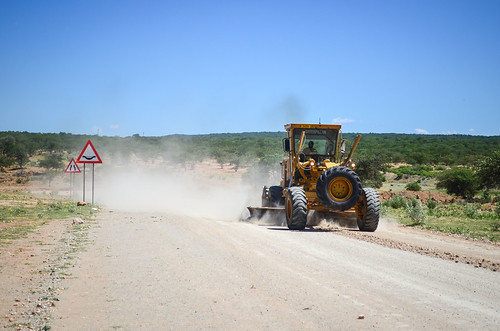

It’s very hot in this Kaokoland/Kaokoveld. I’m drinking all the time, and even accept gladly a 5 L water bottle from tourists. There is nothing to watch around but Himba and cattle.
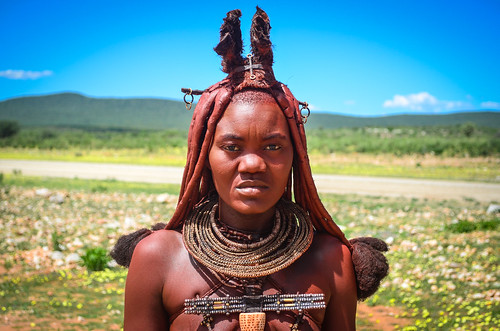
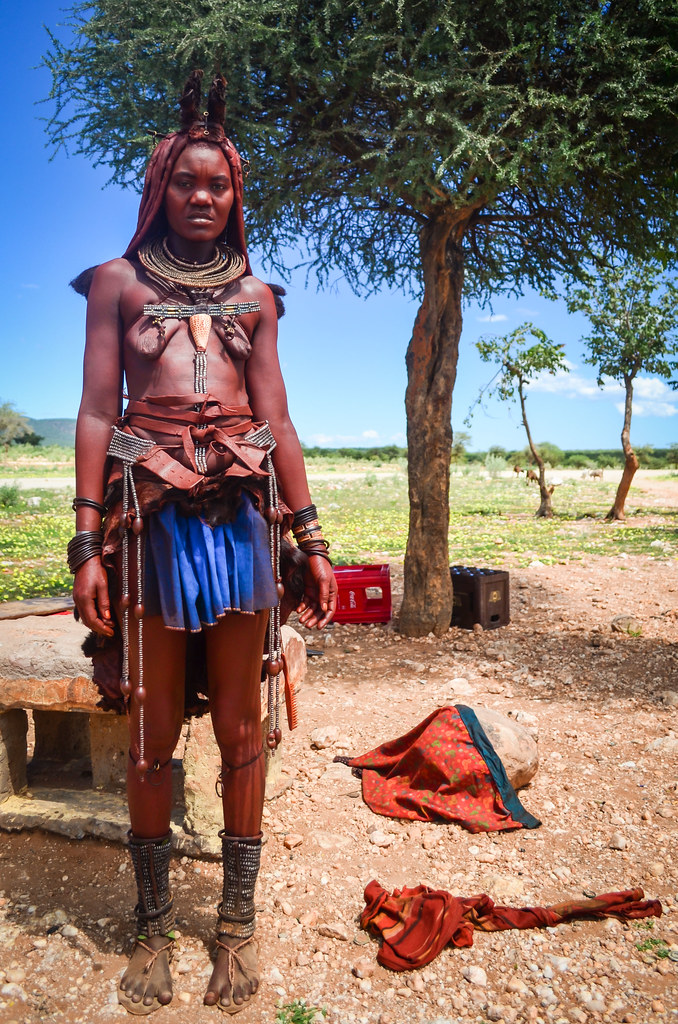

The gravel road is so nice I end up reaching Opuwo with one hour of daylight left. Opuwo is the first town I am encountering in Namibia and it’s much needed: I have very little cash and I need to buy new shoes, as my feet are touching the ground and I’m not too keen on walking in the bush. I don’t know how the Himba manage to walk and run barefoot in a land covered with thorn bushes.
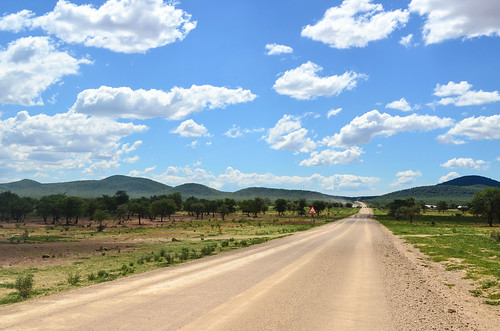
Opuwo is the capital of the Kunene region with a population of 15’000. It has two or three large supermarkets: a little paradise! I can’t find biltong, my favorite snack, but I make it up with biltong-flavored cheese. Candies, diary products, brown bread … it’s so convenient. It sounds ridiculous to say that, but my definition of supermarket over the past months had evolved into “a magical place that exists only in capital cities and sell crazy expensive imported goods for the expat community“. Here, a pack of olives is 1 USD and not 5 USD, because it’s a product of South Africa and not imported from Europe. Well, almost everything comes from South Africa. The main banks as well, and their ATMs are taking Maestro debit cards (much smaller cash withdrawal fees than credit cards)(I have not used mine since Senegal). No alcohol is sold from Saturday noon until Monday morning. The danger of supermarkets is that I can buy a lot of delicious and uncommon groceries, but then I struggle to make them fit in my panniers.
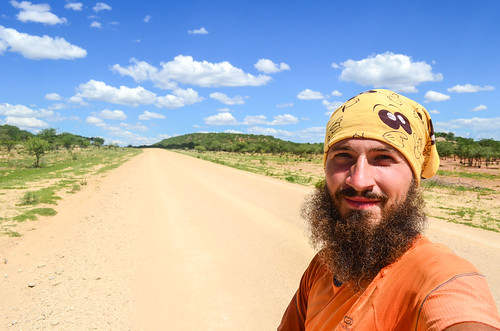
I find the shampoo I used to have while working in Joburg. The funniest moment is when I see that old Himba woman, dressed traditionally, talking to herself in front of the dozen of different butter blocs. Probably an “only in Opuwo” time.
Opuwo is also home to a small community of Herero. The Herero are a parent group of the Himba, but they dress very differently. Like if they have been punished by the first missionaries for walking around half naked, Herero women wear today a long impractical dress and a hat looking like a military radar.
Like in South Africa, there are security guards for supermarkets and restaurants, and the useless checkout guards, standing two meters behind the cash desks, who see you paying but insist on marking your receipt with a cross.

Unfortunately, my cheap guesthouse with free wifi is fully booked, and I am not paying 70 to 140 N$ for a noisy campsite where wifi is an extra 20 N$ per hour. So despite my urgent needs (new shoes and another mattress that doesn’t leak from a new hole every night), and despite the fact that Opuwo surely deserves much more than a quick visit to the supermarket, I go bush camping out of town with my groceries, on a hill under a clear sky. I’ll sort out my needs in Oshakati, the largest town of Northern Namibia, about three days of cycling away.
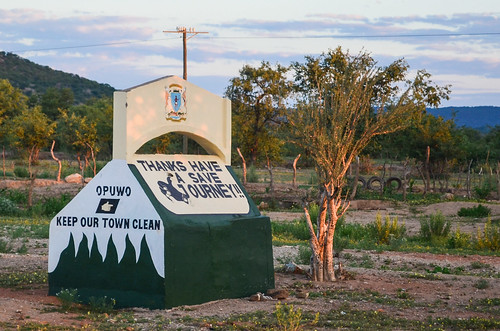







“At least, they are one of the few who are not trying to hide their own hair with fancy wigs and brazilian hair.”
Yea I guess that’s what happen when you kidnap people from their homes, make them into slaves and call them derogatory terms to make them believe that they aren’t beautiful because of their skin AND hair. Interesting
Funny to hear hippie tourists describe my home.